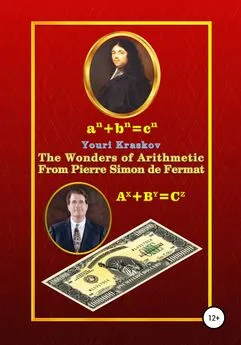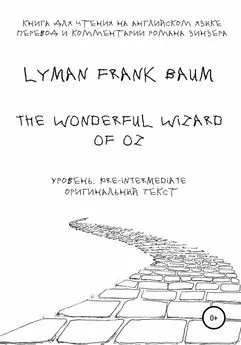Youri Kraskov - The Wonders of Arithmetic from Pierre Simon de Fermat
- Название:The Wonders of Arithmetic from Pierre Simon de Fermat
- Автор:
- Жанр:
- Издательство:неизвестно
- Год:2021
- ISBN:978-5-532-98629-9
- Рейтинг:
- Избранное:Добавить в избранное
-
Отзывы:
-
Ваша оценка:
Youri Kraskov - The Wonders of Arithmetic from Pierre Simon de Fermat краткое содержание
The Wonders of Arithmetic from Pierre Simon de Fermat - читать онлайн бесплатно ознакомительный отрывок
Интервал:
Закладка:
They simply accept as an axiom that all consisting from matter has such properties as mass and energy and so simple the whole problem will be solved. Well, and what about the definition the essence of these properties themselves? But this is still Sir Isaac Newton has very well worked and even used the style of presentation along with approaches from Euclid himself! And now, standing on their shoulders, it’s not at all difficult for us to reveal the essence of these notions especially after physicists have the problem with the units of measurement solved. Indeed, in arithmetic it is only implied that all calculations must be carried out in the appropriate units of measurement while in other sciences these units must always be concrete.
For example, in informatics Bit is used as the unit of measure, but here scientists also screwed up. Since the times of Claude Shannon, it is considered that the quantity of information is measured by Bits, but given that the notion of information is not defined at all, it turns out that they measure unknown what. However, in fact, it is all very well known to everyone that by Bits is measured the capacity of memory of information carrier. But how to measure the quantity of information itself is a problem, the solution of which will largely determine the possibility of implementing the most powerful technological breakthrough in the entire history of our civilization!!!
A term "technological breakthrough" is from the field of economics, but this science is only a ghost if only because it uses as units of measurement only meaningless titles. Economic crises in contrast to the devastating storms, hurricanes and tornadoes, have no natural origin since they are the consequences of people activity who do not understand what they are doing and therefore are not able to prevent them. This book will offer a way to solve these problems from the point of view of the possibilities of building not sham ones, as they are now, but real informatics and economics built in the image and likeness of arithmetic.
From that we have already said, many people will probably think that all this looks like something too fantastic to be a reality. But everyone so thought also about Fermat. When he offered his task to someone, that someone discourses very simply: well, if Fermat is a Gascon, it means a prankster. In Simon Singh’s book about the FLT, Descartes allegedly called Fermat a boast man, what confirms this common opinion, but his exact phrase was: “… unlike Monsieur Fermat, I’m not a Gascon”. If this introduction of ours also will causes distrust or will be perceived as humor then this is exactly what is needed, because it consistent with the spirit of our main hero.
On the other hand, all the themes touched here, are too fundamental to be disclosed in the traditional style of scientific monographs. Then it would have turned out something like, say, the British Encyclopedia or the complete works of Leonard Euler consisting of about 800 volumes, which for more than 200 years anyone had not been able to publish completely at least once. So that our works would not be lost at all, we had to take an extraordinary step i.e. to use for this book an unusual literary genre called here the scientific blockbuster – a combination of narrative in the sharp style of artistic prose along with the separate fragments of purely scientific content .
How one would not to relate to this kind of innovation, here is the result already evident: main themes of the book’s content are presented in detail in 6 points of the “Resume” section and 100 points in the list of Appendix V, which is made up of what will be clearly new to current science. In addition, in order to densify the main content, 172 comments were carried out and three separate miniatures were added as applications, which usually have a reference character but here, they are presented as a natural continuation of the main part of the book, without which it would be incomplete.
The plot of the first miniature is very interesting because in the proof of BTA from German professor Ernst Zermelo (a student of Max Planck himself!) 1912 there is such a barely noticeable error that upon learning of this the authors of the textbooks will be extremely surprised. But no less surprising here is the fact that this error in fact is the same as in the Gerhard Frey’s idea for the FLT "proof" by Andrew Wiles 1995 only more veiled. Thus, the mistake coming from 1912 and appear in 1993 turned out with just terrible consequences, which completely destroyed the "solutions" of two fundamental problems that the scientific world so carelessly allowed himself to admit.
The second miniature is no less curious, because it describes in detail two proofs of the same particular case of FLT for n=4, first by Leonard Euler and then by Pierre Fermat in the reconstruction of I. Bashmakova. Both proof as twin brothers are built on the Pythagoreans identity and in both the descent method is used. They differ only in the intricacies the logic of output to the same end result. These intricacies, although different, are quite complex, what indicates the highest skill of their authors. But the end of this miniature is simply amazing. And indeed, this proof can be obtained from the same Pythagoreans identity literally in a one line (!!!), and this very line is just in the FLT recording we restored in the margins of the book shown in Pic. 5.
In addition to the Euler proof of the special case of FLT presented here, it is also added the full text of all Euler's proofs related to Fermat's grandiose discovery of the truly magnificent properties of primes 4n+1 type. This work required the utmost exertion of all Euler's creative and physical powers within seven years, but the most important proof that these numbers always consist of the sum of two unique squares, is presented by him in such a way that it is unlikely that anyone except himself understands its essence. From Euler's letter to Goldbach with this proof, at first no one understood anything at all, and after the corrected version received by Goldbach in another letter, all the experts tacitly accepted his proof, although it is far from obvious and besides, numbers of this type should be the sum of two unique squares, but about it there is not a single word at all.
Finally, the third miniature is a journey into the past. There will be a lot of surprising and even shocking things, but here we will pay attention to only one a moment. This is the Fermat’s proof of his most grandiose discovery in the field of prime numbers, which is unknown until now and here it is presented by a special way and in amazingly beautiful form. The story about this through the mouth of Fermat's son Clement Samuel with a cherry on the cake in the form of a spectacular equation will make just as colorful an impression as the beauty of nature.
The method of vestment in the verbal form of the content of this book, chosen by us, although it requires an immense strain of all forces from the author, still yields a result, in which a small volume of the book carries the knowledge of thousands of scientific monographs! Perhaps such a precedent will be the first and the last, and in this sense, it is not a competitor to traditional scientific monographs. However, in essence it is just following the simple advice of a classic on choosing a style of exposition, where for words it would be cramped and for thoughts spacious.
The usual technical language does not achieve such an effect and this requires a higher level of literature accessible only to the elect, for example, such as Alexandre Dumas the Father. In one of his books Dumas even argued that writers understand history better than historians. Wherein, he has fib so famously and godlessly that historians could only smirk. However, in fact Dumas turned out be right because the lion’s share of the history set forth in the thick books did not really have place, but was simply invented and this fact also found a place in this book.
One of the features of our literary creativity is the mandatory presence in it of riddles, which are announced, but not disclosed. There is a whole 15 of such riddles in this book, and they are marked (*) in Appendix V (points 18, 19, 26, 27, 39, 41, 42, 43, 44, 45, 46, 47, 48, 69, 74). Questions and problems are focused only on key points that are of principled importance. When such a moment of truth comes, it may give the impression or even bewilderment that science has not noticed such simple things for centuries. But this is where the power of real science lies since the Almighty in his creations always follows only paths with the shortest and simplest solutions.
In real life false knowledge often takes the place of real ones. Behind this lies a lot of danger and unnecessary problems. However, they will bypass those who will be able to understand this book. However, if it will not work for someone, it’s best to turn to children for help and then they will simply be amazed at childish abilities to penetrate into corners of the unknown, which are completely inaccessible to most people. But children themselves do not realize that at their age all people are wizards for whom there are no insurmountable obstacles. Think of although a three-year-old Gauss who made accurate calculations for his father a pipeline engineer. And others can do it too, but they just don’t know about it!
In this book many different names are called, which created history by the will of Providence or case, and just because they turn special attention to themselves they deserve every respect, no matter in what circumstances and how they showed themselves because otherwise, there would simply not be events, from which the plot of our narrative was formed.
From what we have already talked about science here, it will look completely unattractive. Moreover, it will be presented as the source of all troubles, and sadly this is the harsh truth. But if the question about the place of science in society is not raised and, in any way, not clarified, then a catastrophe allegedly coming from scientists, will become inevitable and the very existence of our wonderful world will lose all meaning. This is not at all some formidable warning or apocalyptic prophecy, but merely an ascertaining that science is the only (!!!) field of human activity that predetermines all their other varieties!
Thus, in an intelligent society the highest priority of science must be ensured and supported by all available means, otherwise, it will receive only a global confrontation of ignoramuses balancing on the precarious verge of mutual destruction. And what we have now? Only that the management of society goes not in accordance with the objective laws of the world, but through blatant incompetence, irresponsibility, bribery, adventurism etc. Where is here the science? It is not even near visible anywhere. If even the applied science, which has been robbed by money-lenders to the last thread, somehow can still cling to its existence then for a fundamental science a long time ago there are no any prospects at all.
But perhaps scientists need to offer something themselves so that the fruits of their labor will be appreciated? Ha-ha-ha! There is a well-known case when Gregory Perelman had published without any conditions in free access the proof of the Poincare conjecture, which more than a hundred years apart from him could not be obtained by scientists. However, instead of (already offered to him!) a premium of US$ 1 million he got nothing. The press reported that allegedly he had himself refused under a fictitious pretext, but for some reason all thought that he was just an eccentric. However, in fact he did not even think about refusing, apparently naively believing that the prize he has fully deserved.
Читать дальшеИнтервал:
Закладка:



![О Генри - С высоты козел [From the Cabby's Seat]](/books/1083418/o-genri-s-vysoty-kozel-from-the-cabby-s-seat.webp)






